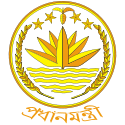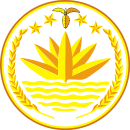- Prime Minister of Bangladesh
-
Prime Minister of Bangladesh 
Seal of the Prime Minister of BangladeshStyle The Honourable Appointer President of Bangladesh Inaugural holder Tajuddin Ahmed Formation 26 March 1971 Website http://www.pmo.gov.bd/ Bangladesh 
This article is part of the series:
Politics and government of
BangladeshConstitutionParliament- Parliament
- Speaker
- Politics
AdministrativeForeign relations
The Prime Minister of the People's Republic of Bangladesh is the Head of the Government of Bangladesh. The Prime Minister and the Cabinet (consisting of all the ministers, who are government department heads) are collectively accountable for their policies and actions to the Jatiya Sangsad Parliament, to their political party and ultimately to the electorate. The current Prime Minister, Hasina Wajed, was elected on December 29, 2008. She and her cabinet was appointed on 6 January 2009 by the Chief Advisor Fakhruddin Ahmed, head of the Interim Caretaker Government of Bangladesh.
Contents
Appointment of the Prime Minister
According to the Constitution the Prime Minister is appointed by the President based upon the result of the electorates choice in parliamentary general election held by the Election Commission. The Prime Minister will be the leader of the majority party (or coalition) in the Jatiya Sangsad and must have the confidence of the Jatiya Sangsad to govern. The cabinet is composed of ministers selected by the prime minister and appointed by the president. At least 90% of the ministers must be MPs. The other 10% may be non-MP experts or "technocrats" who are not otherwise disqualified from being elected MPs. According to the constitution, the president can dissolve Parliament upon the written request of the prime minister.
Duties of the Office
Main article: Prime Minister's Office (Bangladesh)The office of the Prime Minister is located at Tejgaon in Dhaka city. It is considered a ministry of the government and among other duties, provides clerical, security, and other support to the prime minister, governs intelligence affairs, NGOs, and arranges protocol and ceremonies.
Change of government
In September 1991, the electorate approved changes to the constitution, formally creating a parliamentary system and returning governing power to the office of the prime minister, as in Bangladesh's original constitution. In October 1991, members of parliament elected a new head of state, President Abdur Rahman Biswas.[1]
History
Khaleda Zia (BNP)
Khaleda Zia served as Prime Minister of Bangladesh three consecutive times, since 1991. Once in power, Khaleda Zia's government made substantial changes in education policy, introducing compulsory free primary education, free education for girls up to the 10th grade, a stipend for female students, and food for education programme. It also increased the age limit for entry into the civil service from 27 years to 30 years and made highest budgetary allocation in the education sector.
She became Prime Minister for the second consecutive term after the BNP had a landslide victory in 15 February 1996 general election to the sixth Jatiya Sangsad. The election was, however, boycotted by all other major parties who were demanding that the elections be held under a neutral caretaker government, following allegations of rigging in a by-election held in 1994. Turnout was estimated at around 5%, though the government at the time claimed it to be much higher. In the 12 June 1996 polls, BNP lost to Sheikh Hasina's Awami League but emerged as the largest opposition party in the country's parliamentary history with 116 seats.
Aiming to return to power, the BNP formed a four-party alliance on 6 January 1999 with its former political foe the Jatiya Party, and the Islamic party of Jamaat-e-Islami Bangladesh and the Islami Oikya Jot and launched several agitation programmes against the ruling Awami League. In the 2001 general elections BNP won the election with a two-third majority of seats in parliament and 46% of the vote (compared to the principal opposition party's 40%) and Khaleda Zia was once again sworn in as the Prime Minister of Bangladesh.
In 2008 election, they faced a landslide defeat. Khaleda led islamic alliance won only 32 seats and emerged as the smallest oppisition party in the country's parliamentary history. They only won 32% of the vote where their main rival AL won 50 percent of the total vote.
Sheikh Hasina (AL)
Awami League won 146 seats in the 1996 parliamentary elections. The support of the Jatiya Party and a few independent candidates were enough for the 150 or more seats needed for the required majority. Hasina took the oath as the prime minister of Bangladesh. She vowed to create a Government of National Unity. Though some smaller parties and a few individuals from BNP did join the government, the distance between the main two political parties (as well as their leaders) remained as large as ever.
The Awami League succumbed to a landslide defeat in the 2001 Parliament elections. It won only 62 seats in the Parliament, while the Four Party Alliance led by the Bangladesh Nationalist Party won more than 200 seats, giving them a two-third majority in the Parliament. Hasina herself was defeated from a constituency in Rangpur, which happened to contain her husband's hometown, but won from three other seats. Sheikh Hasina and the Awami League rejected the results, claiming that the election was rigged with the help of the President and the Caretaker government. However, the international community was largely satisfied with the elections and the Four Party Alliance went on to form the government.
In December 2008 election, Sheikh Hasina's party won 230 seats giving them the two-third majority in the parliament. She made an alliance with JP and left fronts and her grand alliance won 252 seats in the parliament. Sheikh Hasina took oath as Prime Minister on 6 January 2009.
Political crisis
The scheduled 22 January 2007 elections were marred by controversy. The Awami League and its allies protested, saying that the elections would not be fair because of alleged bias by the caretaker government in favor of Khaleda Zia and the BNP. Hasina demanded that the head of the caretaker government, President Iajuddin Ahmed, step down from that position, and on 3 January 2007, she announced that the Awami League and its allies would boycott the elections.[2] Later in the month, the military led by Army Chief General Moinuddin Ahmed intervened and President Iajuddin Ahmed was asked to resign as the Chief Advisor. Also he was made to declare a state of emergency. A new military-controlled Caretaker government was formed with Dr. Fakhruddin Ahmed as the Chief Adviser. The scheduled parliamentary election was postponed.
2007 interim caretaker government
Main article: Caretaker government of BangladeshOn 12 January 2007, President Iajuddin Ahmed swore in Fakhruddin Ahmed as the Chief Adviser to the Interim Caretaker Government. For a country widely perceived as one of the world's most corrupt, the most dramatic aspect of Fakhruddin Ahmed's rule is his antigraft campaign against the establishment. So far, more than 160 senior politicians, top civil servants and security officials have been arrested on suspicion of graft and other economic crimes.[3] The roundup has netted former ministers from the two main political parties, including former prime ministers Khaleda Zia and Sheikh Hasina and former adviser Fazlul Haque.
List of Prime Ministers
Main article: List of Prime Ministers of BangladeshSee also
- President of Bangladesh
- Foreign Minister of Bangladesh
- Caretaker government
- Politics of Bangladesh
- Caretaker Government
References
- ^ "History overview". Virtual Bangladesh. Virtual Bangladesh. http://www.virtualbangladesh.com/history/overview.html. Retrieved 2008-04-05.
- ^ Haroon Habib, "Polls won't be fair: Hasina", The Hindu, 4 January 2007.
- ^ Time Magazine
Categories:- Politics of Bangladesh
- Government of Bangladesh
- Prime Ministers of Bangladesh
- Parliament
Wikimedia Foundation. 2010.

